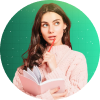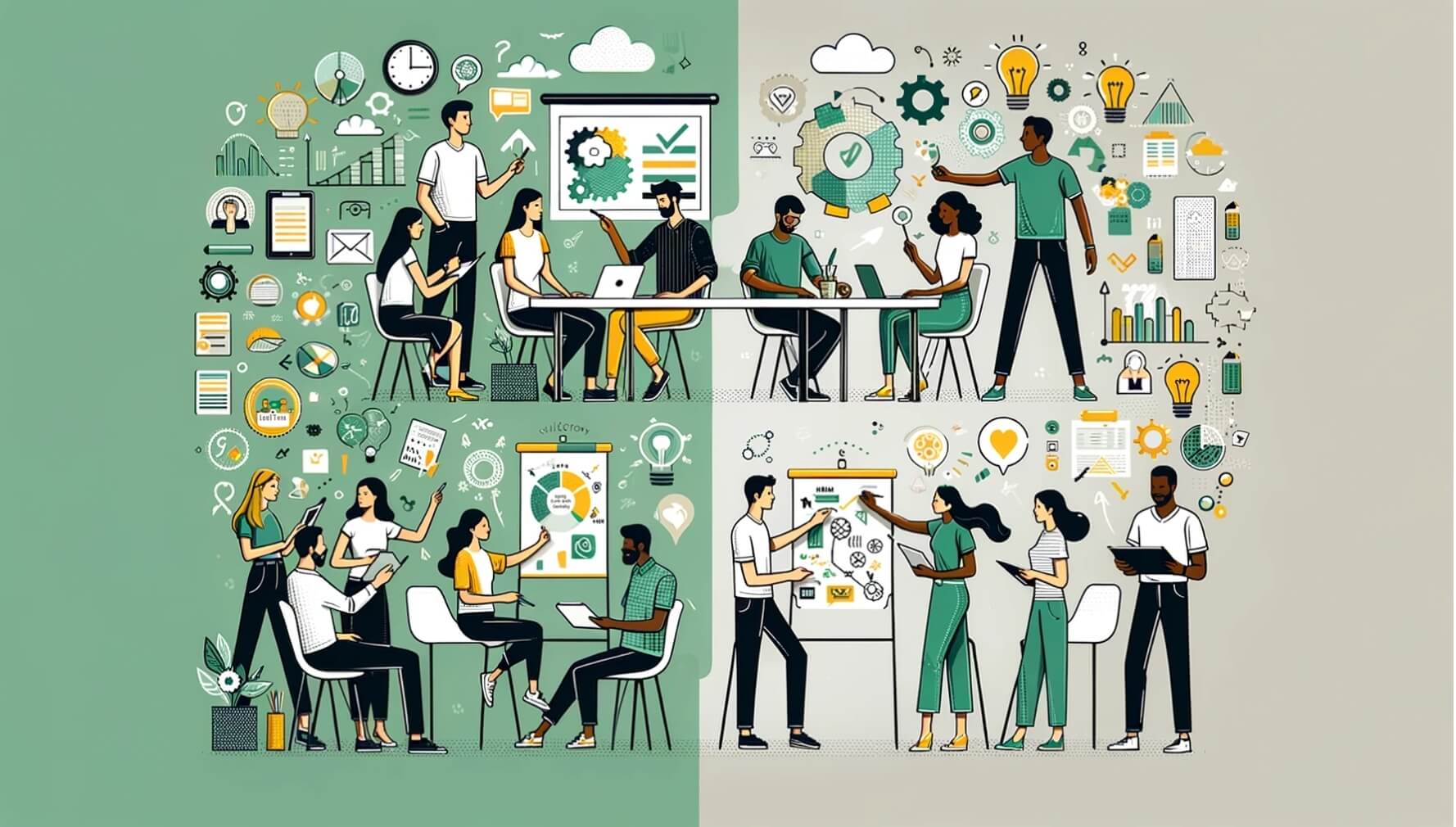Many companies discuss how vital collaboration and teamwork are to their company culture. What does that signify? How can you determine whether the atmosphere at work is collaborative or not?
In a business setting, collaboration is the process of two or more parties working together to accomplish a common objective or complete a project by exchanging resources (knowledge, time, energy, etc.). In contrast, teamwork is the collective action of a group of individuals working towards a shared objective.
In any case, if we want to increase productivity at work, we need all to understand the principles of collaboration and teamwork. Let's explore these two terminologies and their meanings in more detail.
In this article
What is Teamwork?
Teamwork is the symphony in which individual talents blend to reach a common objective. It's an effective combination of teamwork, communication, and shared accountability.
A team, not a collection of solo acts, works toward a common goal by utilizing each member's unique qualities and talents. Open communication serves as a bridge, encouraging understanding and a common goal.
Practical cooperation is more than just dividing chores; it is also about exploiting the diversity of perspectives. Creativity sparks fly when minds from diverse backgrounds mix, resulting in unique ideas and more prosperous outcomes.
But teamwork goes beyond efficiency; it fosters trust and companionship. Shared accomplishments construct a tapestry of pride and joy, while shared adversity forge resilience and adaptation.
What is Collaboration?

Collaboration is the glue that holds people and organizations together, allowing them to do more than they could alone. The secret sauce adds richness and depth to creative activities, problem-solving projects, and even mundane tasks.
Collaboration is really about working together to achieve a common goal. It's a two-way street in which people actively contribute their ideas, skills, and resources to create something bigger and better than the sum of their parts.
Collaboration, however, is more than just brainstorming and handshakes. Open communication, mutual trust, and a willingness to compromise are required. Team members must be able to freely communicate their opinions and concerns, listen to one another actively, and work through conflicts constructively.
Teamwork V.S. Collaboration: What’s the Difference?
Teamwork and collaboration require people to work together to achieve a shared objective, but the two have some significant differences:
- Structure: Teamwork is often more structured, with roles and tasks that are well-defined with clear boundaries. As a result of the decreased focus placed on roles and hierarchies, collaboration has become more fluid and dynamic.
- Decision-making: When working together, it is common for a leader to be the one to make decisions. The collaboration centers more on reaching a consensus, with team members exchanging ideas and working together to reach conclusions.
- Concentration: The primary goal of teamwork is frequently to accomplish tasks effectively. Collaboration's primary goal is to develop novel ideas and modes of operation.
- Communication: Working together as a team demands clear and concise communication, primarily focusing on completing tasks. A collaborative effort necessitates communication that is both open and creative, with an emphasis on the exchange of ideas.
- Results: Working together frequently results in reliable and predictable outcomes. Through collaboration, one can achieve results that are both original and unexpected.
Benefits of Teamwork and Collaboration

Teamwork and collaboration are necessary for success in the job, education, and even in one's personal life. They enable us to accomplish more than we could and benefit individuals and teams.
- Increased efficiency and productivity: When teams collaborate, they can divide tasks and workload, allowing faster completion and increased output.
- Improved problem-solving: A team brings varied viewpoints and experiences together, which can result in more innovative and practical solutions to complicated challenges.
- Enhanced learning and development: Collaboration promotes both professional and personal growth by enabling people to benefit from one another's expertise. It's like having a support system and mentorship network built in.
- Enhanced morale and motivation: Teamwork can promote a sense of belonging, boosting job satisfaction and motivation. Knowing you have a support system can make even the most challenging problems feel more bearable.
- Increased creativity and innovation: Collaboration promotes the free flow of ideas and open communication, which can lead to the development of new and innovative solutions.
- Improved decision-making: By considering various views and points of view, collaborative teams may make more informed and well-rounded conclusions. It's similar to having an in-built sounding board to assist you in avoiding blind spots and biases.
- Greater adaptability and flexibility: Because collaborative teams have a broader range of skills and resources, they are better suited to deal with change and adapt to new challenges.
- Better connections and trust: Cooperation can foster mutual understanding and trust, strengthening people's bonds and creating a happier workplace. It's like constructing a communication and cooperation bridge.
Strategies to Improve Teamwork
Teamwork makes the dream come true, but it takes more than wishful thinking to achieve seamless collaboration. Here are some efficient strategies for boosting your team's synergy and propelling you toward shared success:
- Define the dream: Begin by defining clear, attainable goals that everyone understands and supports. Consider it like planting a flag on the summit to guide your team's ascension.
- Gather the avengers: Look for people with unique skills and viewpoints to create a dynamic blend of strengths. Imagine the Justice League pooling resources to defeat any threat!
- Master the synergy language: Promote active listening, courteous discussion, and clear concept articulation. Consider constructing a bridge of understanding across opposing points of view.
- Celebrate the climb: Acknowledgement increases motivation and promotes excellent habits. Consider high-fives and cheers on the way to the summit!
- Embrace obstacles: Create a culture of learning from mistakes and adapting to unexpected circumstances. Remember that even superheroes endure challenges, but their perseverance characterizes their triumph.
- Enhance morale: Shared experiences develop ties and enhance morale. Consider team outings, sports, or simply laughing together over coffee.
Strategies to Improve Collaboration
Collaboration, the ingredient that converts individual potential into collective victories, is at the heart of any successful team. However, if you use the correct technology, you can get streamlined productivity to create practical cooperation. EdrawMind, for example, provides a platform for your team's collaborative activities.
Collaborative Mind Mapping and Brainstorming
Consider a whiteboard full of ideas, except this time, it's digital and available to everyone. The collaborative mind mapping function in EdrawMind allows team members to brainstorm in real-time, visually linking ideas, taking notes, and voting on the most promising ones.
This dynamic canvas promotes open conversation, invites different points of view, and generates creative solutions.
Fishbone Diagram Analysis: Cause and Effect
Collaboration isn't always about coming up with new ideas but also understanding the "why" behind them. The fishbone diagram tool in EdrawMind provides a visual framework for studying the fundamental causes of problems or identifying the components that contribute to success.
By mapping out the cause-and-effect links, teams can obtain more profound insights, make more informed decisions, and better future outcomes.
Concept Map Analysis: Mapping the Relationships
Understanding the relationships between various concepts is critical for efficient collaboration, especially when dealing with complicated tasks. The concept map tool in EdrawMind enables teams to visually represent relationships between ideas, subjects, or even activities.
This comprehensive viewpoint promotes common understanding, enables knowledge exchange, and assists teams in identifying any gaps or redundancies in their approach.
Keeping Everyone on Track with Task Management
Juggling many tasks and deadlines is common in collaboration. The task management capabilities incorporated into EdrawMind, such as Gantt charts and to-do lists, help teams stay organized and accountable.
EdrawMind guarantees that everyone is on the same page and working towards the same objective by assigning tasks, setting deadlines, and tracking progress in real-time.
Fostering a Collaborative Culture Beyond the Tool
While EdrawMind is useful, remember that collaboration is ultimately a cultural movement. Encourage open conversation, active listening, and tolerance for different points of view.
Celebrate successes and learn from mistakes together. Regardless of the tools you choose, you can unleash the entire potential of cooperation by establishing a foundation of trust and shared purpose.
Remember that EdrawMind is only one example of a technology that can help with cooperation. The goal is to select tools that meet the demands of your team and complement your existing workflow. Your team can accomplish incredible things by combining the correct tools with a commitment to collaboration.




